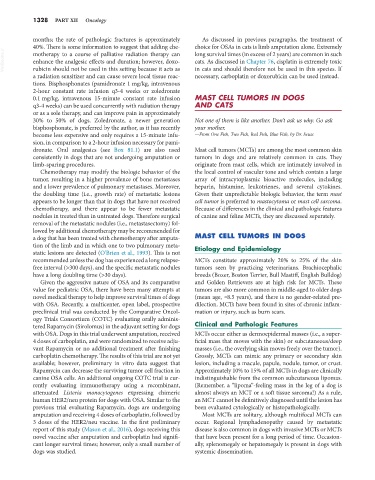Page 1356 - Small Animal Internal Medicine, 6th Edition
P. 1356
1328 PART XII Oncology
months; the rate of pathologic fractures is approximately As discussed in previous paragraphs, the treatment of
40%. There is some information to suggest that adding che- choice for OSAs in cats is limb amputation alone. Extremely
VetBooks.ir motherapy to a course of palliative radiation therapy can long survival times (in excess of 2 years) are common in such
cats. As discussed in Chapter 76, cisplatin is extremely toxic
enhance the analgesic effects and duration; however, doxo-
rubicin should not be used in this setting because it acts as
necessary, carboplatin or doxorubicin can be used instead.
a radiation sensitizer and can cause severe local tissue reac- in cats and should therefore not be used in this species. If
tions. Bisphosphonates (pamidronate 1 mg/kg, intravenous
2-hour constant rate infusion q3-4 weeks or zoledronate
0.1 mg/kg, intravenous 15-minute constant rate infusion MAST CELL TUMORS IN DOGS
q3-4 weeks) can be used concurrently with radiation therapy AND CATS
or as a sole therapy, and can improve pain in approximately
30% to 50% of dogs. Zoledronate, a newer generation Not one of them is like another. Don’t ask us why. Go ask
bisphosphonate, is preferred by the author, as it has recently your mother.
become less expensive and only requires a 15-minute infu- —From One Fish, Two Fish, Red Fish, Blue Fish, by Dr. Seuss
sion, in comparison to a 2-hour infusion necessary for pami-
dronate. Oral analgesics (see Box 81.1) are also used Mast cell tumors (MCTs) are among the most common skin
consistently in dogs that are not undergoing amputation or tumors in dogs and are relatively common in cats. They
limb-sparing procedures. originate from mast cells, which are intimately involved in
Chemotherapy may modify the biologic behavior of the the local control of vascular tone and which contain a large
tumor, resulting in a higher prevalence of bone metastases array of intracytoplasmic bioactive molecules, including
and a lower prevalence of pulmonary metastases. Moreover, heparin, histamine, leukotrienes, and several cytokines.
the doubling time (i.e., growth rate) of metastatic lesions Given their unpredictable biologic behavior, the term mast
appears to be longer than that in dogs that have not received cell tumor is preferred to mastocytoma or mast cell sarcoma.
chemotherapy, and there appear to be fewer metastatic Because of differences in the clinical and pathologic features
nodules in treated than in untreated dogs. Therefore surgical of canine and feline MCTs, they are discussed separately.
removal of the metastatic nodules (i.e., metastasectomy) fol-
lowed by additional chemotherapy may be recommended for
a dog that has been treated with chemotherapy after amputa- MAST CELL TUMORS IN DOGS
tion of the limb and in which one to two pulmonary meta- Etiology and Epidemiology
static lesions are detected (O’Brien et al., 1993). This is not
recommended unless the dog has experienced a long relapse- MCTs constitute approximately 20% to 25% of the skin
free interval (>300 days), and the specific metastatic nodules tumors seen by practicing veterinarians. Brachiocephalic
have a long doubling time (>30 days). breeds (Boxer, Boston Terrier, Bull Mastiff, English Bulldog)
Given the aggressive nature of OSA and its comparative and Golden Retrievers are at high risk for MCTs. These
value for pediatric OSA, there have been many attempts at tumors are also more common in middle-aged to older dogs
novel medical therapy to help improve survival times of dogs (mean age, ≈8.5 years), and there is no gender-related pre-
with OSA. Recently, a multicenter, open label, prospective dilection. MCTs have been found in sites of chronic inflam-
preclinical trial was conducted by the Comparative Oncol- mation or injury, such as burn scars.
ogy Trials Consortium (COTC) evaluating orally adminis-
tered Rapamycin (Sirolomus) in the adjuvant setting for dogs Clinical and Pathologic Features
with OSA. Dogs in this trial underwent amputation, received MCTs occur either as dermoepidermal masses (i.e., a super-
4 doses of carboplatin, and were randomized to receive adju- ficial mass that moves with the skin) or subcutaneous/deep
vant Rapamycin or no additional treatment after finishing masses (i.e., the overlying skin moves freely over the tumor).
carboplatin chemotherapy. The results of this trial are not yet Grossly, MCTs can mimic any primary or secondary skin
available; however, preliminary in vitro data suggest that lesion, including a macule, papule, nodule, tumor, or crust.
Rapamycin can decrease the surviving tumor cell fraction in Approximately 10% to 15% of all MCTs in dogs are clinically
canine OSA cells. An additional ongoing COTC trial is cur- indistinguishable from the common subcutaneous lipomas.
rently evaluating immunotherapy using a recombinant, (Remember, a “lipoma”-feeling mass in the leg of a dog is
attenuated Listeria monocytogenes expressing chimeric almost always an MCT or a soft tissue sarcoma!) As a rule,
human HER2/neu protein for dogs with OSA. Similar to the an MCT cannot be definitively diagnosed until the lesion has
previous trial evaluating Rapamycin, dogs are undergoing been evaluated cytologically or histopathologically.
amputation and receiving 4 doses of carboplatin, followed by Most MCTs are solitary, although multifocal MCTs can
3 doses of the HER2/neu vaccine. In the first preliminary occur. Regional lymphadenopathy caused by metastatic
report of this study (Mason et al., 2016), dogs receiving this disease is also common in dogs with invasive MCTs or MCTs
novel vaccine after amputation and carboplatin had signifi- that have been present for a long period of time. Occasion-
cant longer survival times; however, only a small number of ally, splenomegaly or hepatomegaly is present in dogs with
dogs was studied. systemic dissemination.

